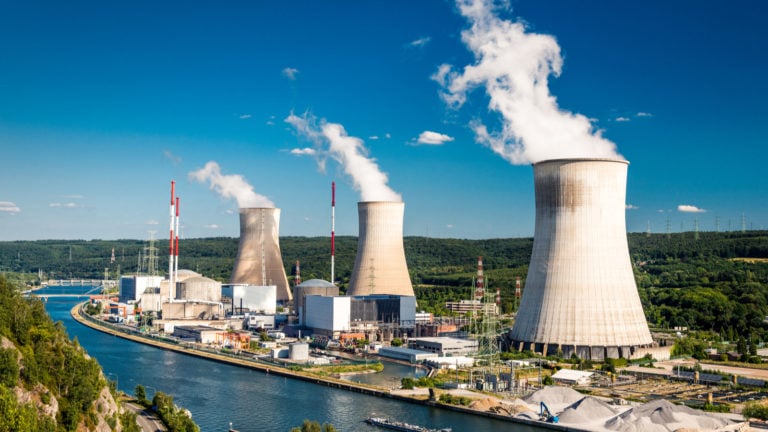Hello, Reader.
On Saturday, 94-year-old Warren Buffett announced that he will retire as the CEO of Berkshire Hathaway Inc. (BRK-A, B) at the end of this year.
In his remarks at his company’s annual shareholder meeting, the legendary investor shared some well-earned insights… one of those being the importance of finding the right “sound.”
While Buffett was referring to finding the right career, the value of discovering a good fit, of something that just works, can be applied to, well, anything…
Like data centers and nuclear energy.
Now, artificial intelligence relies on data centers to handle its computational needs. AI requires immense amounts of processing power for training and running large language models (LLMs), and data centers provide this power.
But there’s a problem: As we get further and further down the Road to AGI, the technology demands such spectacular volumes of electric power that existing sources are not able to provide enough. During the last three years alone, the combined electricity consumption of data center giants like Amazon.com Inc. (AMZN), Meta Platforms Inc. (META), Microsoft Corp. (MSFT), and Alphabet Inc. (GOOGL) soared more than 80%.
That explosive growth is certain to continue.
So, the companies that are building AI data centers need to find the right “sound” to fulfill their energy needs. And when it comes to powering the data centers that support AI, one “sound” – nuclear energy – has no equal.
So, in today’s Smart Money, I’ll break down how Big Tech’s energy needs are reviving the nuclear industry…
Then, I’ll share one specific way you can capitalize on its future.
Let’s dive in…
Power to the… Tech Companies
Earlier today, nuclear developer Elementl Power said that has signed an agreement with Google to develop three sites for advanced reactors.
Google is committing funding for the early-stage development of the sites, the locations of which remain unknown. Each site will generate at least 600 megawatts of power capacity, and Google will be able to buy the power once the sites are up and running.
“Our collaboration with Elementl Power enhances our ability to move at the speed required to meet this moment of AI and American innovation,” said Amanda Peterson Corio, the global head of data center energy at Google.
This isn’t Google and Alphabet’s first nuclear deal. Back in October, the company announced it will purchase power from Kairos Power, a developer of “small modular reactors.”
This deal was significant because small modular reactors (SMRs) promise to reduce the cost of building new nuclear plants.
An SMR is a type of advanced nuclear reactor that can produce electricity. It has a smaller footprint and can be constructed faster than traditional reactors. They are about a third the size of the average reactors in the current U.S. fleet, with a power capacity of 300 megawatts or less – which could power more than 200,000 U.S. households.
As such, SMRs could revitalize nuclear as a vital power source needed for the rise of AI (and electric vehicles and automated factories and warehouses).
Around the same time that Google inked its deal with Kairos, Amazon announced that Amazon Web Services (AWS) – its cloud computing platform – is set to invest more than $500 million in nuclear power.
AWS signed an agreement with Dominion Energy Inc. (D), Virginia’s top utility company, to explore the development of an SMR near Dominion’s North Anna Nuclear Generating Station.
And in September, Microsoft made a deal with Constellation Energy Corp. (CEG) to restart a reactor at the infamous Three Mile Island nuclear facility in Pennsylvania.
So, it’s clear that as the tech giants need to feed the Road to AGI’s growing appetite for electric power, they are investing directly in nuclear power.
And this is where the profit opportunity comes in…
Capitalizing on the Right “Sound”
This new high-profile demand for nuclear power from Big Tech and, sooner than we think, AGI could accelerate growth and profitability in the uranium industry.
To capitalize on that potential, I recommend investing in what’s turning into one of the “soundest” plays in the stock market: the uranium sector.
Today, the U.S. heavily relies on uranium imports for its nuclear power plants, mainly from Canada, Kazakhstan, and Russia. Of course, under the Trump administration’s tariff regime, needed imports from other countries can be worrisome.
However, uranium is currently exempt from the tariffs imposed by the U.S. on imports from Canada.
Now, it’s true that the current $67.73 spot price for uranium is down from its 2024 high of $89, according to Cameco Corp. (CCJ), one of the world’s largest uranium producers. But this number is still significantly higher than the 2023, 2022, and 2021 spot prices of $52.93, $53, and $28.90, respectively.
And the long-term uranium prices remain steady, holding at the $80 level. This is a possible indicator of the market’s long-term potential.
So, the underlying structural case for uranium remains strong. As we head down the Road to AGI, that’s supported by the growing global demand for data centers and, thereby, nuclear energy.
That is why I currently recommend a unique energy play to my Fry’s Investment Report members that stands to benefit directly from the growth of AI and its need for power.
Regards,
Eric Fry
P.S. Earlier this afternoon, the Federal Reserve held rates steady… and joined me in warning of uncertainty. Tomorrow, we’ll bring you a video conversation between InvestorPlace Senior Analyst Louis Navellier and our Editor in Chief, Luis Hernandez, in which they’ll talk about the Fed’s decision… what it might mean for the stock market and the economy… and what comes next. Watch for it tomorrow afternoon.


